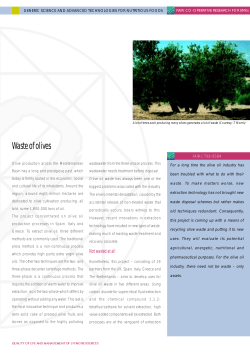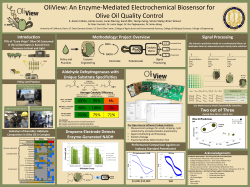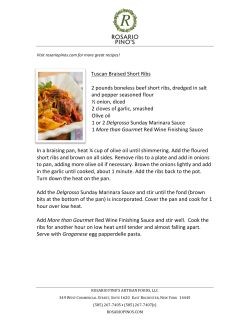
Treatment of Olive Oil Process Waste Water
_________________________________________________________________________________________ Treatment of Olive Oil Process Waste Water 1. 2. Introduction Waste Water Characteristics and Treatment Process 2.1 The Feed Water 2.2 Process Options 2.3 Treatment Steps 3. Conclusion Page 1 _________________________________________________________________________________________ Treatment of Olive Oil Process Waste Water 1. Introduction The olive tree is one of the oldest culture plants. It originates from the Orient, where it has been cultivated for thousands of years. In Greece it has its own myth, because Pallas Athenae is told to have planted an oil tree in Crete. Another legend tells that a pigeon with an olive tree branch has been the sign for the end of the Flood. The olive oil is usually extracted by means of centrifuges. After harvesting and cleaning of the olives, they are processed through hammer mills and centrifuges to separate the oil from solids and waste water. There are 2 methods of separation machines: a) 3-phase decanters with the addition of water, typically 10 – 30 % of the amount of olives. The 3 phases leave the separator as solids through the conical part of the drum, as waste water and hydrostatically as light weight oil. The oil is usually polished to reduce the content of water for better storage characteristics. b) 2-phase decanter without addition of separation water. This method is mainly used to save precious water. The mixture of solids and waste water is separated from the oil, whereby the efficiency is approximately 1 – 2 % higher compared to alternative a). The typical waste water amount per 1000 kg of olives is as follows: a) approx. 250 l separation water from Tricanter approx. 400 l from the olives approx. 50 l from separator/polishing approx. 350 l washwater total approx. 1000 l b) approx. 350 l washwater approx. 50 l from separator/polishing total approx. 400 l Water content of the olives stays in the solid waste and is evaporated in a drying machine before further solvent-extraction. Page 2 _________________________________________________________________________________________ 2. Waste Water Characteristics and Treatment Process 2.1 The Feed Water For a long time, several groups of researchers from the Mediterranean Basin Countries have been carrying out studies concerning the effluents from oil mills in the endeavour to find solutions to the high polluting characteristics of this by product of olives´ processing. Waste water produced in the oil mills is named “vegetation water – VW” (the decomposed watery juice squeezed out from the olives during the oil extraction phase) plus the “external” water needed to carry on the producing process. The volumes of effluents range from a minimum of 0,5 m³ to a maximum of 1,0 m³ per ton of olives, depending on the quality and ripeness of the olive and on the pressing process. The high concentration of organic substances in the waste water pushes its chemical oxygen demand (COD) up to 100 – 160 g/l with a minimum level of 25 – 40 g/l (vegetation water obtained from olives stored in reception bins and centrifuged via a continuous process). The environmental risk in disposing of such effluents is very high (traditionally the effluents were dumped into public water ways or onto arable land surfaces) not only because the high demand of oxygen swings the balance of water out of equilibrium, virtually destroying, in the extreme cases, all underwater life forms, but also because of bad odours, proliferation of insects, growth of certain micro organism (Pseudomonas) and inhibition of certain other useful soil micro organisms and fungi. The question of environmental hazard caused further work to be done in the area of recovering compounds contained in the waste waters and transforming them to produce industrial and commercially marketable products. In fact the “chemistry” of vegetation waters is extremely complex since they contain sugars and other carbohydrates, polyphenols, aldehydes, ketones, pigments, more than 30 organic acids, vitamins, minerals etc. In the past 20 years, several technologies have been tested: • Application of multiple evaporation systems • Application of cryogenic techniques • Anaerobic digestion • Bioprocessing • Ultrafiltration, reverse osmosis, electro dialysis But the response of the industry has been in most cases very cool also because, right or wrong, there is a feeling of reluctance to invest money in a permanent plant, which operates only for 45 – 60 days per year during the olive harvesting and crushing season. Page 3 _________________________________________________________________________________________ The development of the membrane process was envisaged in the endeavour to find a viable solution to the environmental problem of safely disposing of the waste waters and at the same time to separate and concentrate valuable compounds in the olive whey. The investigations, studies and experiments led to the conclusion that the application of semi-permeable membrane technology could be the right reply to this objective and could also be utilized to the treatment of other “difficult” waste waters. The idea was that a physical process encompassing all its components in a limited space to easily and quickly move the plant in and out from one site to the other could be of interest of industries having a short seasonal productive cycle. Membrane separation systems, for their compactness and modularity are the best option to comply with this requirement but their narrow tolerance to certain chemical products and constraints in handling any kind of feedstock as it is, impose a careful study which cannot be limited to the application of theoretical models. In the process design of such type of plants, the first learning step involves the in depth knowledge of the characteristics of the raw water and the possible interactions of the chemical species among themselves at different temperature, pH and pressure. In general terms one m³ of vegetation water is composed by 830 kg of water and 170 kg of dry residue, 20 kg of the residue are minerals and 150 kg organic compounds. The fundamental organic compounds may vary between the following values: Component Sugars Nitrogen substances Organic acids Polyalcohols Polyphenols Residual oil kg/m³ 20 - 80 12 - 24 5 - 15 5 - 15 3-8 3-5 Since the vegetation water is mixed with the oil mill process water, the concentration of the chemical species in the waste water is very much variable, in addition, since waste waters are generally stored in earth ponds, the content of suspended solids is very high and includes not only mucilage, pectin, oil, olive pulp, but also leaves, clay, silt and several tribes of insects. The physical aspect of the waste water is that of a liquid of dark brown colour on top of which floats a thick brownish crud, heavily populated by living organisms and, in the warm season, by Syrphidae larvae, which grow in waters with a high organic content. Page 4 _________________________________________________________________________________________ Typical analyses of vegetation water show the following average concentrations of: ION Na+ K+ Ca++ Mg++ Fe+++ ClSO4-PO4---- INORGANIC IONS mg/l 280 6200 510 120 170 470 370 1050 and the following parameters: pH COD mg/l BOD5 mg/l Suspended solids mg/l Conductivity µS/cm 4,9 – 5,8 40000 - 160000 15000 - 60000 5000 - 10000 10000 – 20000 The objective of the project was to produce a permeate that could be reused as process water or disposed in a water stream (A) or dumped in the sewerage (B): min (A) 5,5 160 80 0,5 pH COD mg/l Suspended solids (mg/l) Phenols max (B) 9,5 500 200 1,0 The characteristics of the concentrate had to be a marketable product such to allow its disposal at no cost or with a profit margin. 2.2 Process Options The investigations on the potentially viable treatment technologies and the study of the results achieved both at laboratory and at industrial level provided the following indications: a. Lagooning: requires large surfaces, does not completely eliminate pollutants, give raise to very bad odours and to contamination of the soil and ground water aquifer. b. Biological treatment: since the waste is over concentrated treatment performance, although substantial, does not meet the standards of currently enforced legislation. Page 5 _________________________________________________________________________________________ c. Anaerobic digestion: cannot be applied to the waste as such. It requires high level dilution which consequently increase reaction volumes and reduce the specific energy output. CSTR reactors take too long to start-up and are therefore incompatible with the seasonal nature of olive oil pressing. d. Evaporation: it is an energy intensive process which gives rise to polluting condensates and because of the high temperatures, entrains alterations of thermo labile organic substances. e. Controlled fermentation: low conversion yields, unsuitable treatment procedure, not yet tested at an industrial level. f. Cryoconcentration: high treatment output, relatively low energy consumption, compatible with seasonal or intermittent production. g. Ultrafiltration/Reverse Osmosis: remarkable flexibility, low energy consumption, 2.3 Treatment Steps The development of the combined filtration-membrane process was envisaged in the endeavour to find a viable solution to the environmental problem of safely disposing waste waters with high concentrations of different pollutants which normally interfere with the cleaning processes in standard waste water treatment plants or are non biodegradable at all. The field of application for this system is wide spread and covers besides the olive oil whey treatment e.g.: • • • • • • Landfill leachate Disposal companies Washing waters from milk and cheese processing Effluents from biogas or co-fermentation plants Effluents from Sludge dewatering ….and many more The developed process includes the following steps: 1. Pretreatment • dosing of flocculants for precipitation of solids and clarification of the supernatant liquid or use of ultrafiltration • pH-adjustment to prepare for further processing in the membrane plant 2. Combined Filtration process Reverse osmosis is the finest level of filtration available. The RO membrane acts as a barrier to all dissolved salts and inorganic molecules, as well as organic molecules with a molecular weight greater than approximately 100 Dalton. This means it can reject Page 6 _________________________________________________________________________________________ molecules with the molecular weight of 100 well (i.e. >90%). Substances with a smaller molecular weight (e.g. ethanol, methanol,..) can still pass the membranes and cause a high level of COD and a severe exceeding of the needed discharge parameters. These substances can only be brought under the effluent limits by the use of special filtration materials which will adsorb the molecules because of their large specific surface. Further on chemical and biological processes within this filtration layers will lead to a significant decrease which will improve the systems efficiency regarding mainly COD. 3. Membrane separation process A multi step Reverse Osmosis (RO) process has shown best results in purifying the pretreated waste water. No high energy demanding high pressure RO is applied for the brine since the brine is recycled in the first RO stage. The pressure demand remains at appr. 15-20 bar. The brine from the RO units will be recycled back. When mixed with the newly incoming waste water the brine will enhance the water quality which will further improve the process´ efficiency. The average power consumption is in the range of 3 to 4 kWh/m³. The typical hydraulic recovery rates of the membrane steps range from 65 - 85 %, depending on the individual conditions. This means that 15 – 35 % of the waste water is continuously recycled back to the filtration where it is mixed with the incoming raw-water. So it is treated again and cleaned by means of the chemical and biological processes taking place on the adsorbing materials. There is no discharge waste water in this process. Only the absorbent content of some filters has to be removed periodically. The complete plant is installed either on a steel frame or in a mobile 20´ or 40´ standard container, which may be easily transferred to any site of use by truck. As an option the RO-section of the plant may be operated separately to desalinate seawater, producing potable water according to international standards. 3. Conclusion Waste water from olive mills are hazardous to the environment and require expensive storage areas. Membrane plants with combined AC and RO-process have proven the ability to treat these effluents very effectively, producing a water quality suitable for reuse, irrigation or disposal. The advantages for the oil mill operators are as follows: • • • less civil structure for storage tanks the negative environmental influences are solved the process is cost-effective and economically feasible Page 7
© Copyright 2025





















